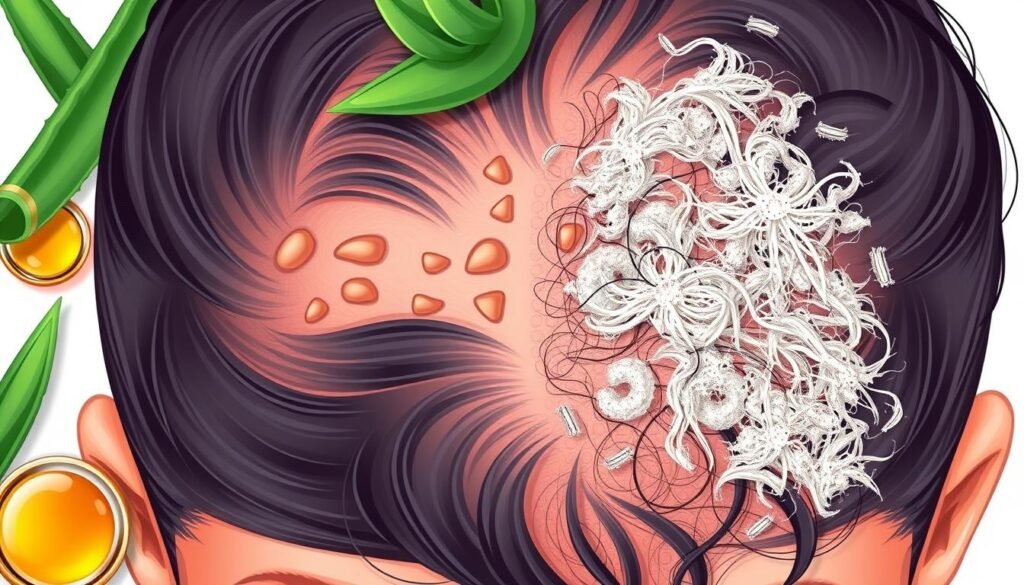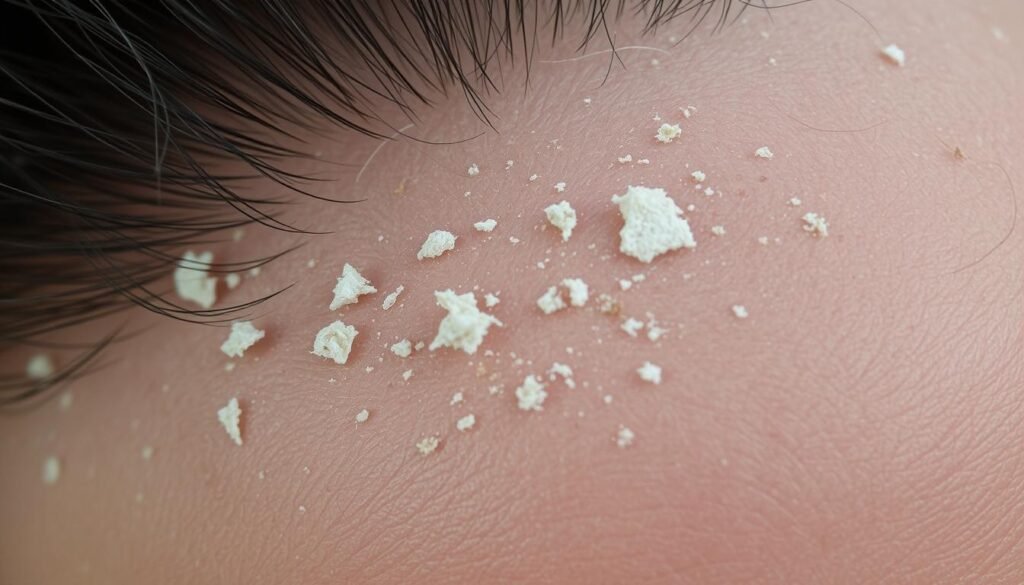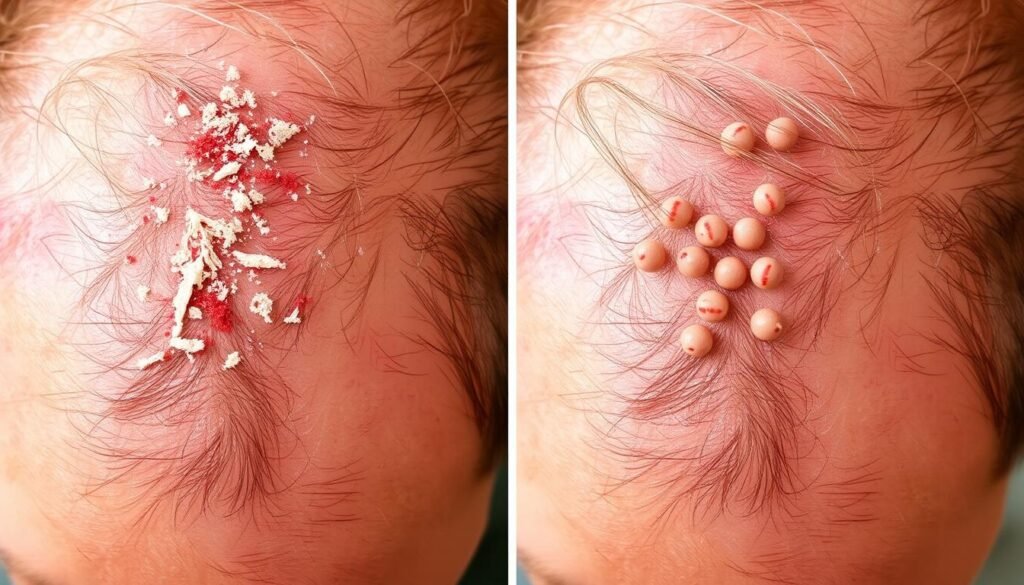About half of the adult population deals with dandruff at some time. This common problem can cause a lot of discomforts. It often shows up as itching and irritation on the scalp.
Knowing the signs of dandruff is important. It can affect how a person feels about themselves and their social life. Signs include hair getting thinner, skin flaking off, and constant irritation.
By spotting these symptoms early, people can look for the right treatments. This way, they can improve the health of their scalp.
Key Takeaways
- Dandruff affects nearly half of adults at some stage in their lives.
- Itching and scalp irritation are common symptoms of dandruff.
- Dandruff can result in social stigma and uncomfortable situations.
- Flaking skin and redness often accompany the condition.
- Recognizing symptoms helps in finding effective treatments.
- Maintaining scalp health is essential for overall well-being.
Understanding Dandruff
Dandruff is a common scalp issue, seen as dead skin shedding. People with it often feel itching and discomfort. It’s caused by things like dry or oily skin, and too much yeast, leading to conditions such as seborrheic dermatitis.
Keeping your scalp healthy is key to fighting dandruff. It’s important to find what’s causing it to treat it right. Often, shampoos with special ingredients like zinc pyrithione or salicylic acid can stop the fungus and reduce flakes.
| Causes of Dandruff | Symptoms | Treatment Options |
|---|---|---|
| Dry Skin | Flaking and Itching | Moisturizing shampoos |
| Oily Skin | Redness and Irritation | Medicated Shampoos |
| Yeast Overgrowth | Persistent Flaking | Shampoos with Zinc Pyrithione |
| Skin Conditions | Scalp Inflammation | Salicylic Acid Treatments |
The Role of Scalp Health
Keeping your scalp healthy is key to fighting dandruff. A well-nourished scalp can keep moisture in and irritants out. Various things can harm scalp health, making dandruff and itching worse.
Pollution and harsh weather can hurt the scalp’s health. Not cleaning your scalp well can lead to dead skin and oil buildup, which invites dandruff. Imbalanced scalp flora causes it to itch a lot.
To fight these problems, wash your scalp regularly with the right shampoos. Adding moisturizing treatments helps with dryness and itching. Using gentle hair products and avoiding too much heat styling also helps keep your scalp healthy.

| Factors Affecting Scalp Health | Impact on Dandruff | Solutions |
|---|---|---|
| Environmental Stressors | Can exacerbate dryness and irritation | Use protective products and limit exposure |
| Poor Hygiene | Leads to buildup of skin cells and oil | Regular cleansing regimen |
| Imbalanced Scalp Flora | Contributes to inflammatory responses | Probiotic treatments to restore balance |
| Heat Styling | Can cause damage and dryness | Avoid excessive heat and use protective sprays |
Itching and Scalp Irritation
Itching and scalp irritation distress many individuals. Knowing the symptoms early helps in finding the right treatment. Signs like redness, flaking, and soreness are common. Spotting these early is key to managing them well.
Identifying Symptoms
People with itching and scalp irritation may notice different symptoms. These include:
- Redness: The scalp might look red and inflamed.
- Flaking: Flakes can show up signaling dandruff or similar issues.
- Soreness: Itching or irritation can make the scalp sore.
Causes of Itching
Many things can cause itching and scalp irritation. The most common causes are:
- Dryness: A dry scalp can be very itchy.
- Allergic Reactions: Some hair products might cause reactions.
- Weather Changes: Changes in the season can affect your scalp.
- Skin Disorders: Problems like eczema or psoriasis lead to irritation.
Dry Scalp and Dandruff Connection
It’s crucial to know how dry scalp and dandruff are linked. A dry scalp can cause more flakes, itchiness, and irritation. Things like weather can greatly affect how moist your scalp is. This can make dandruff worse. So, it’s key to keep your scalp hydrated.
Impact on Scalp Moisture
Dry scalp happens when it lacks moisture, leading to discomfort and flaking. Things like low humidity make it worse. This doesn’t only bring out dandruff but also severe itching. Balancing moisture is important to relieve these problems.
Treatment Options for Dry Scalp
There are treatments to lessen dry scalp and dandruff problems. A good step is to use shampoos made for dry scalps. Adding oils and moisturizers can bring back the moisture, reducing itching and flaking. Including dietary supplements might also help your scalp’s health. For more on supplements that work, check out this resource on fighting dandruff. Using these treatments regularly can really help make your scalp healthier and more comfortable.
Types of Dandruff: Seborrheic Dermatitis
Seborrheic dermatitis is a tough type of dandruff on oily areas, like your scalp. It’s important to spot its symptoms. This helps tell it apart from other skin issues for good care.
Symptoms of Seborrheic Dermatitis
Symptoms of seborrheic dermatitis can really bother you. They include:
- Red patches on the scalp and other areas.
- Yellowish, oily flakes may fall from the scalp.
- It can make your scalp irritated and sensitive.
Differences from Other Conditions
It’s key to know how seborrheic dermatitis differs from other skin issues. This is crucial for finding the right treatment.
| Feature | Seborrheic Dermatitis | Psoriasis | Eczema |
|---|---|---|---|
| Affected areas | Scalp, face, body folds | Elbows, knees, scalp | Hands, feet, behind the knees |
| Flake appearance | Oily, yellow flakes | Thick, silvery scales | Dry, crusty areas |
| Redness | Present | Consistent | Variable |
Understanding these differences helps in diagnosing correctly. Treatments like corticosteroids and antifungals can control seborrheic dermatitis. They fight inflammation and manage symptoms well.
Understanding Hair Loss Related to Dandruff
Chronic dandruff often leads to persistent itching and irritation. These symptoms can harm your hair’s health. Scratching the scalp to ease discomfort may harm hair follicles.
This damage can cause temporary hair loss. This can be worrying for those dealing with dandruff.
To tackle hair loss from dandruff, look for gentle hair care products. Choose ones that fight dandruff and encourage healthy hair. It’s key to find treatments that ease scalp irritation.

It’s important to understand how these issues are connected. A personalized treatment plan can keep your scalp and hair healthy. Seeking advice from a professional helps ensure you use the best methods.
| Symptoms | Impact on Hair | Recommended Treatments |
|---|---|---|
| Itching | Can lead to hair loss due to scratching | Anti-dandruff shampoos and soothing scalp treatments |
| Irritation | May stress hair follicles, causing temporary thinning | Moisturizing conditioners and scalp oils |
| Dandruff | Continued presence can exacerbate hair loss | Medicated shampoos with active ingredients |
Scalp Psoriasis and Its Symptoms
Scalp psoriasis is different from dandruff, although they seem alike because of flaking. It’s not just light flakes; it shows up as thick, red patches with a silver scale. Being chronic and autoimmune, it does more than itch mildly.
- Severe itching that may cause discomfort
- Painful lesions which can bleed or crack
- Thickened skin patches that are often resistant to over-the-counter treatments
Figuring out if you have scalp psoriasis needs a doctor’s visit. Dermatologists tell it apart from dandruff by looking and learning your health story. Treatments change based on how severe the psoriasis is.
| Treatment Method | Description |
|---|---|
| Topical Steroids | Reduces inflammation and relieves itching effectively. |
| Light Therapy | Utilizes UV light to slow skin cell turnover. |
| Systemic Medications | Administered for severe cases, addressing the entire body. |
It’s crucial to understand scalp psoriasis, from its distinct signs to managing it. Recognizing how it’s different from dandruff is key for the right treatment.
Differentiating Folliculitis from Dandruff
It’s crucial to know the difference between folliculitis and dandruff for the right treatment. Folliculitis is inflammation that affects hair follicles. On the other hand, dandruff is mainly about dry skin causing flakes. Folliculitis shows as red bumps and can have pus-filled blisters. This can be uncomfortable and may scar if not treated right.
Dandruff appears as dry, white flakes on the scalp. It’s less about inflammation and more about skin cells shedding quickly. This can happen due to dry skin among other causes. While people can have both conditions, knowing each one’s symptoms helps in finding the best treatment.

| Feature | Folliculitis | Dandruff |
|---|---|---|
| Symptoms | Red bumps, pus-filled blisters, discomfort | White flakes, itching, dry scalp |
| Causes | Bacterial or fungal infection | Dry skin, seborrheic dermatitis |
| Location | Affects hair follicles, may extend beyond the scalp | Primarily occurs on the scalp |
| Treatment | Topical or oral antibiotics | Anti-dandruff shampoos and scalp moisturizers |
Knowing these conditions well can improve how we manage them. Identifying their unique signs and symptoms is key to choosing the right treatment.
Conclusion
Knowing about dandruff is key to solving problems like itching and scalp irritation. By spotting the signs and linking them to different conditions, people can improve their scalp health. This lets them pick treatments that suit their own needs.
Caring for your scalp regularly helps make it healthier. Picking products wisely and keeping clean are important too. These steps cut down on dandruff and make the scalp feel better.
To sum up, a complete approach to manage dandruff includes recognizing symptoms, choosing the right products, and regular scalp care. This approach not only eases itching and irritation but also revives the scalp, making it healthy.